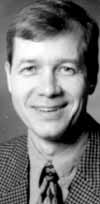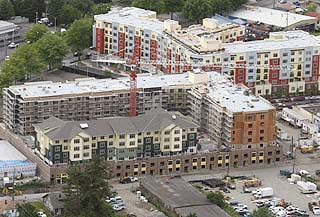
DJC.COM
March 30, 2006
Brownfield project demonstrates Seattle's creative know-how
GeoEngineers

Cook
|
Rainier Court, the new urban village in the heart of Seattle’s Rainier Valley, has been getting local press for more than a year because of its public-private partnerships, creative engineering and innovative housing on top of a brownfield.
Just a few years ago, the seven-acre Rainier Court area was an eyesore, plagued with illegal dumping, abandoned cars, leaking underground storage tanks and hazardous chemicals. The site was not only a place for criminal activity but also a public health concern.
EPA honor
Now that cleanup and construction are complete — with about 400 units of affordable housing for families and seniors and 15,000 square feet of commercial and retail space — national and even international audiences are taking notice.

Photo courtesy of GeoEngineers
Rainier Court in South Seattle recently won EPA’s highest national brownfield redevelopment award. Innovative approaches helped trim more than $1 million from cleanup costs and accelerate the approval process.
|
The EPA recently named Rainier Court one of the most innovative redevelopments in the country and honored the project with the 2005 Phoenix Award — EPA's highest honor for a project of this kind. The award committee called Rainier Court a "national model."
This was only the second time the Pacific Northwest had received this distinction. According to Tim Brincefield of EPA Region 10 (which encompasses Alaska, Idaho, Oregon and Washington), "Rainier Court was the most complex brownfield project ever undertaken and successfully completed in our region."
The Phoenix Award recognizes innovative, practical remediation projects arising from new national brownfield initiatives, which bring blighted commercial and industrial sites back to productive use.
Rainier Court also recently received the Silver Award for Sustainable Design from the American Council of Engineering Companies of Washington.
Culture of creativity
Rainier Court's recognition is evidence of our region's culture of creativity.
Richard Florida, author of "The Rise of the Creative Class," was keynote speaker at the 2005 National Brownfields Conference, where the Phoenix Award was presented. He emphasized that sustainable development, including reutilizing brownfields, highlights the abilities of the creative class.
"The creative process," said Florida, "flourishes in places that provide the broad ecosystem which nurtures and supports creativity and channels it into innovation, new firm formation and ultimately economic growth and rising living standards."
Florida rates Seattle among the nation's top three cities in his "creativity index."
Innovative designs saved more than $1 million in cleanup costs at Rainier Court, and greatly accelerated the regulatory approval process. The remedy consisted of excavating 30,000 tons on contaminated soil, carefully positioning building footprints and hardscaping to eliminate contact with contaminants, and applying a vapor barrier to prevent intrusion into living areas. All remedies were scrutinized by the state Department of Ecology, resulting in a fix that protects human health and the environment.
International case study
On the global scene, Seattle City Council member Peter Steinbrueck talked up Rainier Court at a conference in Nantes, France. The only American speaker, he described Rainier Court as a case study to nearly 250 attendees from throughout Europe.
"The international audience was very enthusiastic about Rainier Court, and saw it as a stellar example of urban revitalization and brownfields reclamation," Steinbrueck said.
"The Europeans were especially surprised that the project took place in the United States, which they view as a very consumptive society. Also, they were impressed that a coalition of nonprofits shouldered the lion's share of the financing, a role typically assumed by governmental groups on the other side of the Atlantic."
Public-private partnerships
Steinbrueck was referring to the unprecedented collaboration among public and private groups that made Rainier Court a reality.
Southeast Effective Development (SEED), a nonprofit community group, spearheaded Rainier Court and was joined by the Department of Ecology, EPA Region 10, King County, the city of Seattle and the state Department of Community, Trade and Economic Development.
The public-private partnership helped Rainier Court qualify for innovative tax credits and low-interest loans. The sense of joint ownership also opened access to public officials and regulators, and helped accelerate both funding and permitting processes.
"Phase I of Rainier Court provided affordable housing, and created about 150 construction jobs and up to 50 permanent jobs," said Seattle Mayor Greg Nickels.
"Clearly, Rainier Court has made a difference in people's lives in this community that has long been overlooked for reinvestment and redevelopment."
An attractive environment
Pat Chemnick, director of SEED, agreed.
"We learned from Rainier Court that it's important to provide appropriate incentives," she said.
"The economics must pencil out for each business, industry or developer who takes a risk on an overlooked neighborhood. Public-private partnerships, tax credits, tax abatement, loans, grants, financial offsets, rezoning and other incentives should all be considered in the mix to create an attractive environment for development."
"Attractive environment" is what Rainier Court has been all about — for developers, engineers, residents and planners. And as Florida points out, a creative environment excites people, provides stimulating places to live, work and play, and breeds further creativity. We can therefore view Rainier Court as an indicator of even more innovative development concepts in the future.
David Cook of GeoEngineers is a brownfields redevelopment specialist and the associate-in-charge of Rainier Court. GeoEngineers is an earth science and technology consulting firm with offices in six states.
Other Stories:
- Tips for designing an energy-efficient building
- Toward a sustainable future in South Lake Union
- Historic preservation projects can be green
- Low-impact development gets a test in Renton
- Smart lighting design: go for timeless, not trendy
- 3 advances show the future of site development
- What does a sustainable school cost?
Copyright ©2009 Seattle Daily Journal and DJC.COM.
Comments? Questions? Contact us.